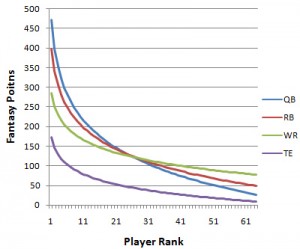Game Theory in Fantasy Football
http://thedctimes.com/2010/06/fantasy-football-and-game-theory-understanding-your-opponents-beliefs/
Any male college student that hasn’t been raised by wolves has heard of fantasy football, and a vast majority of them have probably been involved in a draft in their lifetime. From Ivy League scholars to the Wendy’s night shift employees, fantasy football can be enjoyed by anyone with even the slightest knowledge of the game. People love to say it is unpredictable and just a form of gambling, but there are proven methods that help some players finish at the top of their leagues year after year. One technique used by the geekiest of fantasy experts is the value over replacement player (VORP) strategy. VORP measures the predicted value of a player, given the predicted point total of the worst starting player available at that position (i.e in a 10 person league, a quarterbacks VORP would be their projected points minus the projected points of the 10th best passer, since each team only starts one quarterback).
This strategy is very useful in determining the relative value of each player. If the first ranked running back is projected 300 points, and the first best quarterback is projected 250, the average fan might be immediately inclined to take the runner. However, in choosing players based merely on their own projected stats, owners miss out on the chance to maximize the overall value for their team. In fantasy, the optimal strategy is not necessarily to choose the best player at each selection, but rather to pick players with the greatest value relative to the ones that will be available in later rounds. This principle is illustrated in the graph below.
While some positions are overall higher scorers than others, what owners should be looking at is the slope of each graph. A greater slope means a larger gap between adjacently ranked players, and therefore a higher VORP.
When we look at fantasy football in this way, we can see how closely it relates to game theory. When making a selection, the owner must consider how the other members of the draft will act so they can have an idea of who will be available at their next pick. Owners are not only drafting their own team, they must do so based on how they think every other owner will draft.
Let’s show this with an easy example. Supposed you have the 7th pick in a draft with 10 people. Let’s say the six picks in front of you were all running backs, and when you pick again at 14th overall, you expect to choose between the 10th ranked running back, the 3rd best wide receiver and the 4th best quarterback. The difference in point values between the 7th best running back and the 10th best running back is probably smaller than the difference between the best quarterback and the 4th best, despite the face that running backs may score more points. Again, utilizing this strategy during a draft will allow owners to maximize the total value of their team, not necessarily each pick. Hmm, trying to maximize utility while taking into account the actions of others? Sounds awfully familiar…
– jbheavy

